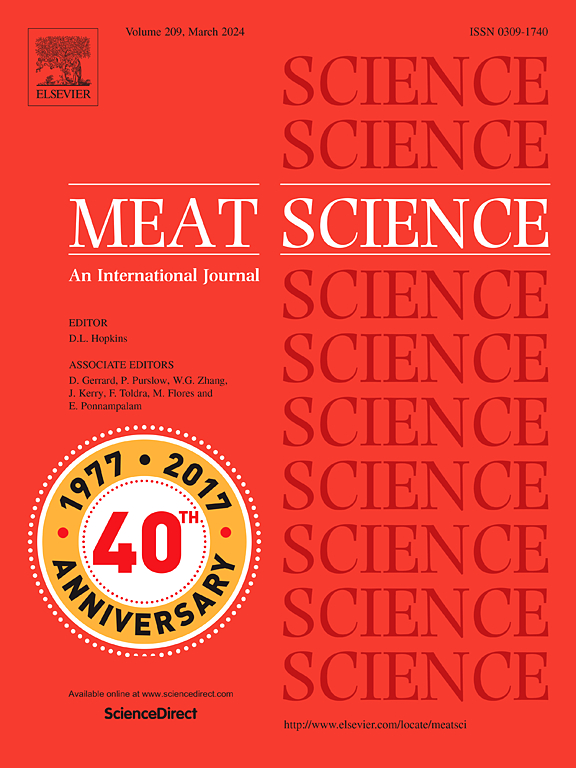Impact of varying visual severities of dark-cutting beef on the biochemical color characteristics, retail color, and metabolome of longissimus lumborum steaks
IF 6.1
1区 农林科学
Q1 Agricultural and Biological Sciences
引用次数: 0
Abstract
The objective was to evaluate the impact of varying visual severities of unaged dark-cutting beef on the retail color attributes and metabolite profile of beef longissimus lumborum steaks. Beef carcasses (n = 8/treatment) were selected at the time of grading from a commercial facility based on the visual degree of dark-cutting severity. Treatments included a bright cherry-red colored normal-pH control, shady, moderate, and moderately severe dark-cutting beef. Retail color, pH, bloom color, oxygen consumption, metmyoglobin reducing activity, lipid oxidation, and untargeted metabolomics analysis using gas chromatography mass-spectrometry were determined. pH and lightness (L* values) were normal-pH (5.51, 37.56), shady (5.90, 36.96), moderate (6.33, 35.38), and moderately severe (6.40, 32.65), respectively. Normal-pH beef had a lower (P < 0.05) metmyoglobin reducing activity than moderate and moderately severe dark-cutting beef. There were no differences (P > 0.05) in oxygen consumption between different shades of dark-cutters, but normal-pH had lower oxygen consumption (P < 0.05) than moderately severe. Metabolite profiling indicated downregulation of glucose, fructose-6-phosphate, and glucose-6-phosphate, while there was an upregulation of amino acid and lipid-based metabolites such as isoleucine, threonine, and glyceryl monopalmitate in all three dark-cutting severities compared with normal-pH beef. The abundance of succinic acid was lower in all shades of dark-cutting beef than in normal-pH beef. In the pairwise comparisons to normal-pH beef, there were 12, 21, and 43 metabolites significantly different for shady, moderate, and moderately severe, respectively. As dark-cutting severity increases, metabolites linked to energy metabolism change, including a decrease in glycolytic metabolites.
不同视觉程度的黑切牛肉对腰最长肌牛排的生化颜色特征、零售颜色和代谢组的影响
目的是评估不同视觉程度的未老化黑切牛肉对腰最长肌牛肉的零售颜色属性和代谢物特征的影响。牛肉尸体(n = 8/处理)是在分级时根据视觉上的暗切严重程度从商业设施中选择的。处理包括明亮的樱桃红色正常ph值控制,阴凉,中度和中度重度深切牛肉。使用气相色谱质谱法测定零售色、pH值、开花色、耗氧量、肌红蛋白还原活性、脂质氧化和非靶向代谢组学分析。pH和亮度(L*值)分别为normal-pH(5.51, 37.56)、shady(5.90, 36.96)、moderate(6.33, 35.38)和moderate - severe(6.40, 32.65)。正常ph值牛肉的P <;0.05)肌红蛋白还原活性比中度和中度深切牛肉高。没有差异(P >;0.05),但正常ph值下的耗氧量较低(P <;0.05)高于中度重度。代谢物分析表明,葡萄糖、6-磷酸果糖和6-磷酸葡萄糖下调,而氨基酸和基于脂质的代谢物,如异亮氨酸、苏氨酸和单棕榈酸甘油,与正常ph值的牛肉相比,在所有三个暗切严重程度中都上调。所有深切牛肉中琥珀酸的丰度都低于正常ph值牛肉。在与正常ph值牛肉的两两比较中,分别有12、21和43种代谢物在轻度、中度和中度ph值牛肉中存在显著差异。随着暗切严重程度的增加,与能量代谢相关的代谢物发生变化,包括糖酵解代谢物的减少。
本文章由计算机程序翻译,如有差异,请以英文原文为准。
求助全文
约1分钟内获得全文
求助全文
来源期刊

Meat Science
工程技术-食品科技
CiteScore
12.60
自引率
9.90%
发文量
282
审稿时长
60 days
期刊介绍:
The aim of Meat Science is to serve as a suitable platform for the dissemination of interdisciplinary and international knowledge on all factors influencing the properties of meat. While the journal primarily focuses on the flesh of mammals, contributions related to poultry will be considered if they enhance the overall understanding of the relationship between muscle nature and meat quality post mortem. Additionally, papers on large birds (e.g., emus, ostriches) as well as wild-captured mammals and crocodiles will be welcomed.
 求助内容:
求助内容: 应助结果提醒方式:
应助结果提醒方式:


